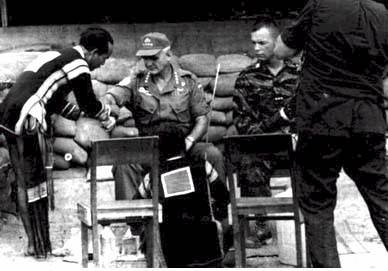 General Westmoreland gets Montagnard bracelet as part of tribal initiation at Mai Linh, camp A-226, 1966. Photo: Ed Sprague
General Westmoreland gets Montagnard bracelet as part of tribal initiation at Mai Linh, camp A-226, 1966. Photo: Ed Sprague
Some higher-up had decided that movies maintained morale. So every large military installation, base camp and tiny outpost in Vietnam was supplied weekly with reels of film for our viewing pleasure. The usual shipment of canisters contained two half-hour television series shows, like Combat and Batman, and a three-reel feature. Often as not, the three reels were mixed up and from different films, but the troops watched them anyway for a lack of anything better to do.
The Montagnard soldiers at the far-flung Special Forces camps enjoyed the feature films immensely, even though they didn’t understand English or – when the reels didn’t match up — the incoherent jumble of stories. While for the most part they understood that the images were probably an illusion, they regularly lost themselves in the dramas and went proactive, shooting up the screen in a kind of real-life precursor of the combat video game. Projecting the movies onto a whitewashed wall proved a problem: their bullets punched holes through the screens — and often through the walls. So the Americans improvised, using a white sheet or bleached mosquito netting hung in front of stacked sandbags to absorb the hits and keep discharged rounds from flying everywhere.
Westerns were a particular favorite of the tribespeople, who naturally enough sided with the Indians (their situations being so similar). But sometime after 1967 their loyalties shifted and they decided the Indians were Vietnamese (whom they didn’t trust or like after years of persecution) and shot them up when they appeared. Suddenly the Yards identified with the cowboys and the cavalry.
I wondered for years what lay behind this shift, and only recently found the answer to the mystery in a moving essay by George “Sonny” Hoffman. His is the best description I’ve ever read of the “Mountain People” and the jocular physicality (especially compared to the fastidious, reserved Vietnamese) that endeared them to the Green Berets they fought alongside. You’ll have to read his essay to find out which lone hero caused this sea change in the Montagnards’ attitude toward cowboys when he accepted initiation into the Rhade tribe. It certainly wasn’t General Westmoreland.
One of those temples came to my attention from a friend, Linh, who has helped me organize many of my charity visits and projects there.